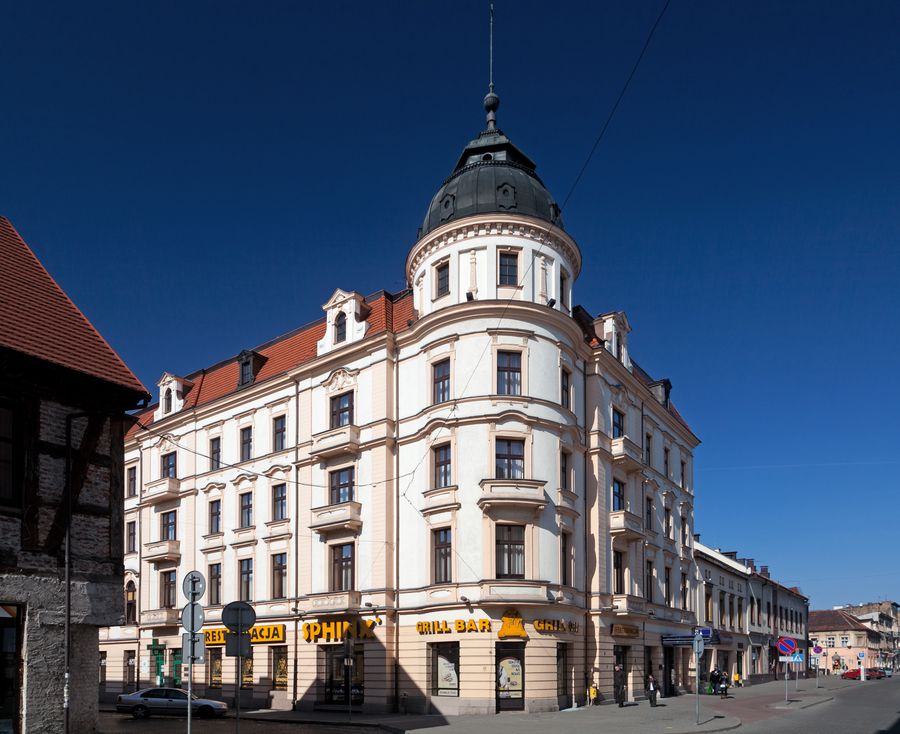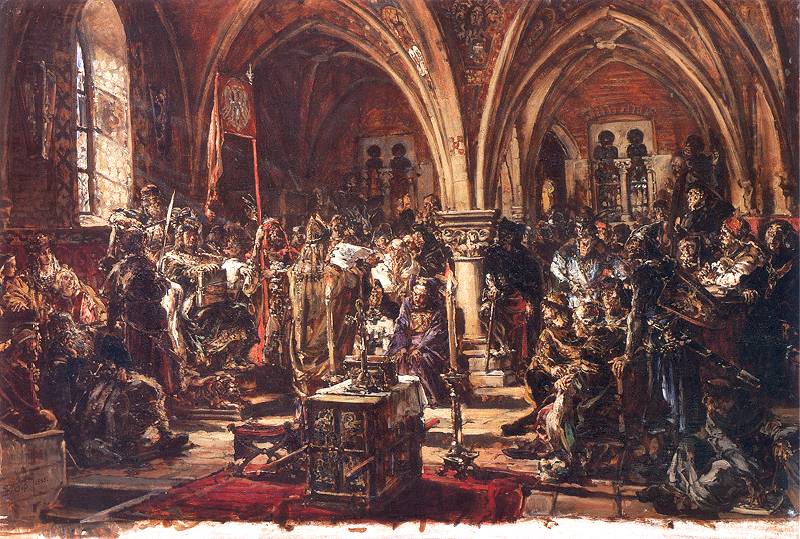|
Wojciech Baranowski
Wojciech Baranowski (1548 – 23 September 1615) was archbishop of Gniezno and primate of Poland. Biography In 1581 he was ordained a priest and became the royal secretary of Stefan Batory, accompanying him during the Pskov campaign. Later in 1581 he became grand secretary to the crown, and by 1585 he was the Crown Deputy Chancellor. In 1587 he signed a recession sanctioning the election of Sigismund III Vasa. Also in 1587, on behalf of the senate, he welcomed Zygmunt III's deputation on a ship in Gdańsk, insisting that he sign a pacta conventa containing a promise to join Estonia to the Polish–Lithuanian Commonwealth. In 1589, he was a signatory to the ratification of the Bytom-Będzin Treaty at the pacification of Sejm.Codex diplomaticus Regni Poloniae et Magni Ducatus Lituaniae, wydał Maciej Dogiel, t. I, Wilno 1758, page. 237. On 30 January 1591, he was appointed bishop of Płock. From 1595-1596 he worked on behalf of the king with Pope Clement VIII. On 14 May 16 ... [...More Info...] [...Related Items...] OR: [Wikipedia] [Google] [Baidu] |
Roman Catholic Archdiocese Of Gniezno
The Archdiocese of Gniezno ( la, Archidioecesis Gnesnensis, pl, Archidiecezja Gnieźnieńska) is the oldest Latin Catholic archdiocese in Poland, located in the city of Gniezno."Archdiocese of Gniezno" ''''. David M. Cheney. Retrieved March 27, 2016"Metropolitan Archdiocese of Gniezno" ''GCatholic.org''. Gabriel Chow. Retrieved March 27, 2016 The |
Ratification
Ratification is a principal's approval of an act of its agent that lacked the authority to bind the principal legally. Ratification defines the international act in which a state indicates its consent to be bound to a treaty if the parties intended to show their consent by such an act. In the case of bilateral treaties, ratification is usually accomplished by exchanging the requisite instruments, and in the case of multilateral treaties, the usual procedure is for the depositary to collect the ratifications of all states, keeping all parties informed of the situation. The institution of ratification grants states the necessary time-frame to seek the required approval for the treaty on the domestic level and to enact the necessary legislation to give domestic effect to that treaty. The term applies to private contract law, international treaties, and constitutions in federal states such as the United States and Canada. The term is also used in parliamentary procedure in deliberati ... [...More Info...] [...Related Items...] OR: [Wikipedia] [Google] [Baidu] |
Bishops Of Płock
A bishop is an ordained clergy member who is entrusted with a position of authority and oversight in a religious institution. In Christianity, bishops are normally responsible for the governance of dioceses. The role or office of bishop is called episcopacy. Organizationally, several Christian denominations utilize ecclesiastical structures that call for the position of bishops, while other denominations have dispensed with this office, seeing it as a symbol of power. Bishops have also exercised political authority. Traditionally, bishops claim apostolic succession, a direct historical lineage dating back to the original Twelve Apostles or Saint Paul. The bishops are by doctrine understood as those who possess the full priesthood given by Jesus Christ, and therefore may ordain other clergy, including other bishops. A person ordained as a deacon, priest (i.e. presbyter), and then bishop is understood to hold the fullness of the ministerial priesthood, given responsibility b ... [...More Info...] [...Related Items...] OR: [Wikipedia] [Google] [Baidu] |
Bishops Of Przemyśl
A bishop is an ordained clergy member who is entrusted with a position of authority and oversight in a religious institution. In Christianity, bishops are normally responsible for the governance of dioceses. The role or office of bishop is called episcopacy. Organizationally, several Christian denominations utilize ecclesiastical structures that call for the position of bishops, while other denominations have dispensed with this office, seeing it as a symbol of power. Bishops have also exercised political authority. Traditionally, bishops claim apostolic succession, a direct historical lineage dating back to the original Twelve Apostles or Saint Paul. The bishops are by doctrine understood as those who possess the full priesthood given by Jesus Christ, and therefore may ordain other clergy, including other bishops. A person ordained as a deacon, priest (i.e. presbyter), and then bishop is understood to hold the fullness of the ministerial priesthood, given responsibi ... [...More Info...] [...Related Items...] OR: [Wikipedia] [Google] [Baidu] |
1615 Deaths
Events January–June * January 1 – The New Netherland Company is granted a three-year monopoly in North American trade, between the 40th and 45th parallels. * February – Sir Thomas Roe sets out to become the first ambassador from the court of the King of England to the Mughal Emperor Jahangir, sailing in the ''Lyon'' under the command of captain Christopher Newport. * March 10 – John Ogilvie, a Jesuit priest, is hanged and drawn at Glasgow Cross in Scotland for refusing to pledge allegiance to King James VI of Scotland; he will be canonised in 1976, becoming the only post-Reformation Scottish saint. * April 21 – The Wignacourt Aqueduct is inaugurated in Malta. * May 6 – The Peace of Tyrnau is signed between Matthias, Holy Roman Emperor, and Gábor Bethlen. * June 2 – The first Récollet missionaries arrive at Quebec City, from Rouen, France. * June 3 – The Eastern Army of Tokugawa Ieyasu and the Osaka Army of Toyotomi ... [...More Info...] [...Related Items...] OR: [Wikipedia] [Google] [Baidu] |
1548 Births
__NOTOC__ Year 1548 ( MDXLVIII) was a leap year starting on Sunday (link will display the full calendar) of the Julian calendar. Events January–June * February 14 – Battle of Uedahara: Firearms are used for the first time on the battlefield in Japan, and Takeda Shingen is defeated by Murakami Yoshikiyo. * April 1 – Sigismund II Augustus succeeds his father, Sigismund I the Old, as King of Poland and Grand Duke of Lithuania. * May 11 – The great fire in Brielle begins. * June ** Ming Chinese naval forces commanded by Zhu Wan destroy the pirate haven of Shuangyu, frequented by Chinese, Japanese and Portuguese smugglers. ** John Dee starts to study at the Old University of Leuven. July–December * July 7 – A marriage treaty is signed between Scotland and France, whereby five-year-old Mary, Queen of Scots, is betrothed to the future King Francis II of France. * August 7 – Mary, Queen of Scots, leaves for France. * October 20 &ndash ... [...More Info...] [...Related Items...] OR: [Wikipedia] [Google] [Baidu] |
Baranowski
Baranowski ( ; feminine: Baranowska, plural: Baranowscy) is a Polish surname. It is Lithuanised as Baranauskas and frequently transliterated from Russian as Baranovsky (feminine: Baranovskaya). The name is also frequently found among Ashkenazi Jews. People Notable people with the surname include: *Agnieszka Baranowska (1819–1890), Polish playwright and poet *Antanas Baranauskas (1835–1902), Lithuanian poet *Danny Baranowsky (born 1984), American electronic music composer * Dariusz Baranowski (born 1972), Polish cyclist *Dmytro Baranovskyy (born 1979), Ukrainian long-distance runner *Gabriel Baranovskii (1860–1920), also Gavriil (Baranovski, Baranowski) Russian architect, civil engineer, publisher and art historian * Henryk Baranowski (1943–2013), Polish theatre director and actor *Hermann Baranowski (1884–1940), German Nazi SS concentration camp commandant *Katarzyna Baranowska (born 1987), Polish Olympic swimmer *Kinga Baranowska (born 1975), Polish mountaineer *Kr ... [...More Info...] [...Related Items...] OR: [Wikipedia] [Google] [Baidu] |
Gniezno Cathedral
The Royal Gniezno Cathedral (The Primatial Cathedral Basilica of the Assumption of the Blessed Virgin Mary and Shrine of St. Adalbert, pl, Bazylika Archikatedralna Wniebowzięcia Najświętszej Marii Panny i Sanktuarium św. Wojciecha) is a Brick Gothic cathedral located in the historical city of Gniezno that served as the coronation place for several Polish monarchs and as the seat of Polish church officials continuously for nearly 1000 years. Throughout its long and tragic history, the building stayed mostly intact, making it one of the oldest and most precious sacral monuments in Poland. The cathedral is known for its twelfth-century (ca. 1175), two-winged bronze doors decorated with scenes of martyrdom of St. Adalbert of Prague and a silver relic coffin of that saint. The coffin was made by Peter von der Rennen of pure silver in 1662 after the previous one, established in 1623 by King Sigismund III Vasa himself, was robbed by the Swedes in 1655, during the Swedish inva ... [...More Info...] [...Related Items...] OR: [Wikipedia] [Google] [Baidu] |
Diocese
In Ecclesiastical polity, church governance, a diocese or bishopric is the ecclesiastical district under the jurisdiction of a bishop. History In the later organization of the Roman Empire, the increasingly subdivided Roman province, provinces were administratively associated in a larger unit, the Roman diocese, diocese (Latin ''dioecesis'', from the Greek language, Greek term διοίκησις, meaning "administration"). Christianity was given legal status in 313 with the Edict of Milan. Churches began to organize themselves into Roman diocese, dioceses based on the Roman diocese, civil dioceses, not on the larger regional imperial districts. These dioceses were often smaller than the Roman province, provinces. Christianity was declared the Empire's State church of the Roman Empire, official religion by Theodosius I in 380. Constantine the Great, Constantine I in 318 gave litigants the right to have court cases transferred from the civil courts to the bishops. This situ ... [...More Info...] [...Related Items...] OR: [Wikipedia] [Google] [Baidu] |
Kujawsko-Pomorskie
Kuyavian-Pomeranian Voivodeship, also known as Cuiavian-Pomeranian Voivodeship or simply Kujawsko-Pomorskie, or Kujawy-Pomerania Province ( pl, województwo kujawsko-pomorskie ) is one of the 16 voivodeships (provinces) into which Poland is divided. It was created on 1 January 1999 and is situated in mid-northern Poland, on the boundary between the two historic regions from which it takes its name: Kuyavia ( pl, Kujawy) and Pomerania ( pl, Pomorze). Its two chief cities, serving as the province's joint capitals, are Bydgoszcz and Toruń. History The Kuyavian-Pomeranian Voivodeship was created on 1 January 1999, as a result of the Polish local government reforms adopted in 1998. It consisted of territory from the former Bydgoszcz, Toruń and Włocławek Voivodeships. The area now known as Kuyavia-Pomerania was previously divided between the region of Kuyavia and the Polish fiefdom of Royal Prussia. Of the two principal cities of today's Kuyavian-Pomeranian voivodeship, one (Bydgos ... [...More Info...] [...Related Items...] OR: [Wikipedia] [Google] [Baidu] |
Sejm
The Sejm (English: , Polish: ), officially known as the Sejm of the Republic of Poland (Polish: ''Sejm Rzeczypospolitej Polskiej''), is the lower house of the bicameral parliament of Poland. The Sejm has been the highest governing body of the Third Polish Republic since the transition of government in 1989. Along with the upper house of parliament, the Senate, it forms the national legislature in Poland known as National Assembly ( pl, Zgromadzenie Narodowe). The Sejm is composed of 460 deputies (singular ''deputowany'' or ''poseł'' – "envoy") elected every four years by a universal ballot. The Sejm is presided over by a speaker called the "Marshal of the Sejm" (''Marszałek Sejmu''). In the Kingdom of Poland, the term "''Sejm''" referred to an entire two-chamber parliament, comprising the Chamber of Deputies ( pl, Izba Poselska), the Senate and the King. It was thus a three-estate parliament. The 1573 Henrician Articles strengthened the assembly's jurisdiction, makin ... [...More Info...] [...Related Items...] OR: [Wikipedia] [Google] [Baidu] |






